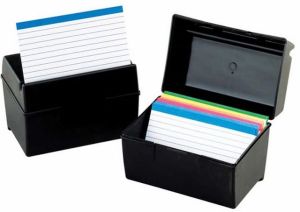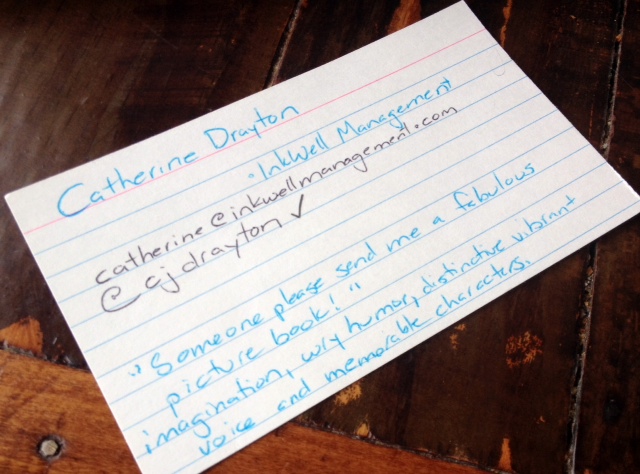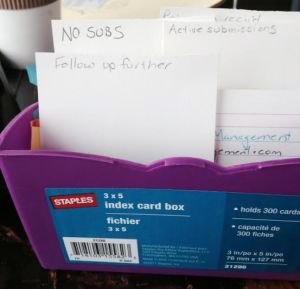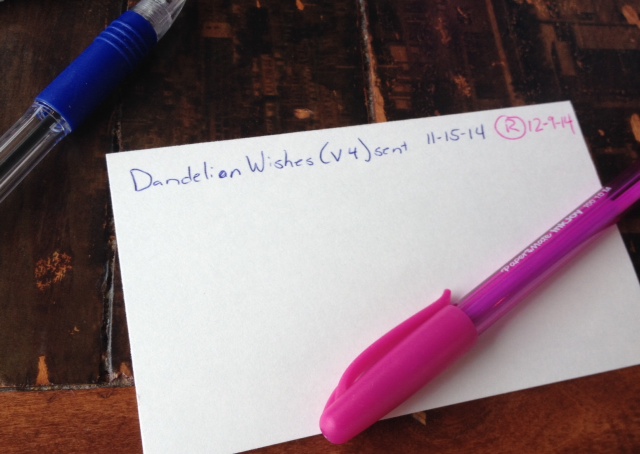We talk about the many different aspects of submissions in our Sub It Club writer’s support group and one day we were talking about submission tracking. Lisha Cauthen showed us how to track submissions with a fancy dancy spreadsheet. I outlined the way I track them in my post, Submission Tracking, Old School. Katey Howes talked about how she tracks her submissions using index cards. When I heard she had a system I knew that we all needed to know more! Today Katey Howes is here to share how she tracks her submissions “Inside the Box:

When it comes to all things writerly, I occasionally wonder if I was born in the right century. I’m no technophobe – I have a laptop, e-reader, smartphone and (might I say) a pretty hopping blog. I even tweet. And yet, when it comes to my writing – and my submissions process – I like the tactility and mobility of good old fashioned office supplies.
Thick, cloth-covered journals. Yellow legal pads. Sticky notes. Ink pens, colored pencils, and, of course, my file box full of index cards.
There are as many ways to track agent and publisher queries as there are writers. Sub It Club has posted very helpful articles on several of them in the past, including this one on using QueryTracker. Many authors and illustrators set up a query tracking spreadsheet in Microsoft Excel or a similar program. If you would like more information on that technique, I’d suggest you go to the Sub It Club Facebook page and search “tracking queries,” as the topic has been discussed there frequently.
When I began querying agents with my first picture book manuscripts, I wanted a system that made it very easy to see when queries had gone out, who they were with, and when it would be okay to send my next manuscript. I tried both a spreadsheet and the QueryTracker tool to record queries. Over time, I found that neither really suited my personal work style, and I went totally old-school instead.
My “inside the box” tracking system requires nothing more than index cards, a file box, and some colored pens. Here’s how it goes.
STEP 1: Find an agent or editor interesting? Write his/her name at the top of an index card. Add important details like agency/publishing house, contact info, and possibly links to interviews or a blog. If you write in multiple genres, you may wish to list which genres the agent represents (MG, YA, etc.) I like to put a quote if I can find one. Like this one from Catherine Drayton at Inkwell Management:
I also like to list the agent’s twitter handle: you’ll see I put a checkmark by Catherine’s in the picture above. That’s my indication that I am following her. I generally add a smiley face when/if they follow me back!
STEP 2: The first place every card goes, for me, is into a section of the file box I label: No Subs. It could as easily be called Potential Agents or Won’t You Be My Neighbor if that kind of thing strikes your fancy. It’s the place for editors and agents I haven’t got a submission with – yet. My incredibly high-tech divider is another index card turned on end.
STEP 3: Once I have a manuscript ready to submit, I can quickly thumb through the No Subs section for potential matches. I pull them all out and arrange them into piles to help me organize “waves” of submissions. Personally, I like to send out a first wave of 8-10 queries on a given manuscript to get a feeling for the impression my query makes. If I get similar responses from several agents, I may make revisions to the query letter or manuscript before the next wave. This method also lets me prioritize agents I think would be great, good, or long-shot matches for a given project. As you can imagine, I often spend a few days shuffling the piles and thinking about strategies and priorities.
STEP 4: Time to flip your cards over. There’s plenty of space on the back. I write the title or an abbreviation of the manuscript I am submitting, along with the date it was sent, here. If there are multiple versions, I will also note that here. As great a tracking system as this is, make sure you also have a folder in your email account where you save the queries you send, and the responses you receive. You can search that later by name, date or keyword.
STEP 5: Time to move those cards! Once you’ve sent out a manuscript to an agent or editor, move his/her card to a section of the box labeled Active Submissions. The awesome thing about this? Well, most editors and agents will only allow one query per author at a time. While the card is in the active submissions section, you won’t be accidentally sending another project to that person (and potentially being labeled an amateur – or worse!)
STEP 6: Your laptop bings or dings or beeps. You’ve got mail! Hopefully, an agent adored your work and wants to talk on the phone. In which case, pull that card and refer back to all those blog posts, tweets and quotes to re-familiarize yourself with her work. More likely, though, it’s the big fat “No” we all get too accustomed to. Use a new color of ink to mark the rejection on your index card, along with the date, and save the email. Return the card to No Subs, throw a 10 minute pity-party, and forge ahead!
There are, of course, other possibilities. Perhaps the agent asked for a revise and resubmit (R&R never sounded less relaxing!) or, in the case of kidlit and short stories, to see a few other examples of your work. You now do an embarrassing dance routine and message your CP’s in a happy panic.
I keep an R&R section in my file box where cards go to wait while I am actively revising. Once I send the revision, I put the index card back in Active Subs. In the case of an agent asking to see more of your work – this is where your brilliant recording skills pay off. The very last thing you want is to send an interested agent a manuscript he rejected a year ago. You also don’t want to send him stories too similar to a project he just sold – so go back and do your homework one more time. (Aren’t you glad you wrote down all his info?)
STEP 7: I’ve always liked to put a weekly “walk through” of my Active Submissions section on my to-do list. This way I stay fresh on what’s out there in the world, and how long it’s been there. Glancing at query dates every so often lets me know if there’s someone I need to gently nudge, or maybe twitter-stalk, before assuming that silence means rejection.
What, you don’t twitter stalk? Sometimes it is incredibly reassuring to find that an agent has been on jury duty since January and is way behind reading her submissions. Some agents are nice enough to post occasional updates for their twitter or blog followers. The amiable Jessica Sinsheimer of Sarah Jane Freyman Literary, for example, kindly keeps curious queriers up-to-date with posts like this one:
And that’s all there is to it, ladies and gentlemen. My simple system in a nutshell. I’d love to hear what works for you, to answer questions you might have, or to benefit from your knowledge to improve my system. Please leave your comments below.
Thank you so much Katey for sharing her submission tracking system with us! I love the flexibility and that the information can be flipped through so easily. Katey is an organizational genius!
——————–
Katey Howes writes picture and chapter books and is working on the manuscript of her first middle grade novel. She recently signed with her agent, Essie White of Storm Literary Agency. You can follow Katey’s blog at www.kateywrites.wordpress.com, where she writes about parenthood, career change, and raising children who love reading. You can also get to know Katey on twitter @kateywrites or by using the hashtag #raisingreaders. When not writing or reading, Katey loves to play outside with her kids, do a little swing dancing with her husband, and discover eateries with fabulous coffee, wine or chocolate. Katey is a member of SCBWI and advocates for improved access to books for kids worldwide.




Katey, I totally appreciate this approach. I have several different spreadsheets and an assortment of post it notes which track the action of a manuscript. However, I realized a few weeks ago I didn’t have good snapshot from the standpoint of agents/publishing houses. (Plus, you had me at index card with colored tops!)
LikeLike
Lauri – I’m so glad this is helpful for you. I knew I wasn’t the only office-supply aficionado out there!
LikeLike
I have actually been a fan of your website for a long period of
time, however this write-up Query Tracking “Inside The Box” by Katey Howes | Sub It Club is the finest.
LikeLike
Just saw this…and I am much like you, Katey…I love the paper and pencil approach. Yes, of course, I’ve got gobs of info on my computer…but somehow that isn’t enough…I love to hold it in my hand. 😉 Thanks for the index card ideas!
LikeLike
Katey – I just saw this. I may adopt your approach! My current approach is not working! 🙂
LikeLike
I love my old school tracking systems, but this method fills a gap I didn’t realize I had. I can’t wait to integrate it into my current system. Thanks so much for sharing it with us.
LikeLike